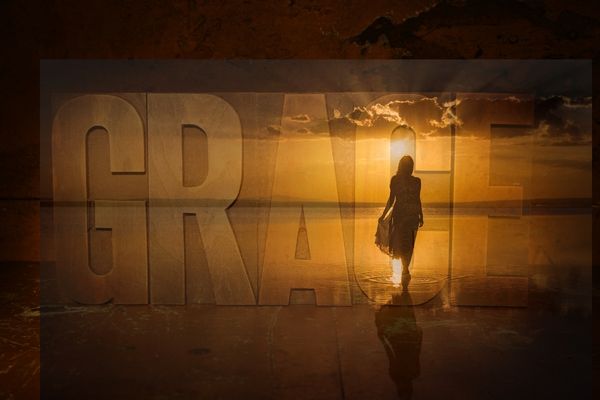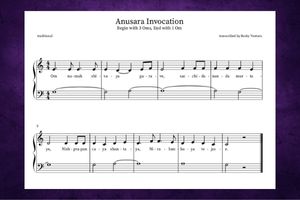Open to Grace
Categories: Philosophy

Open to Grace is a Recognition
“Open to Grace” is one of Anusara Yoga’s premier gifts to the contemporary world of hatha yoga.
Since its inception in 1997, Anusara Yoga practitioners begin each
- asana,
- pranayama,
- philosophy lecture,
- and community gathering
with a moment of recognition, as individuals and as a collective kula, by invoking Grace.
What is Grace?
The concept of Grace, and the desire to “open to Grace,” has been considered in story, myths, religion and philosophy for thousands of years. The Bible often refers to the seeking of, and bestowing of grace, to the faithful by the Lord.
In Greek culture, the Three Graces, the goddesses Euphrosyne, Aglaia, and Thalia, personified and bestowed the attributes of ultimate beauty.
Spanning historic classical Hindu philosophy, a common thread describes unmerited favor spontaneously bestowed on a devout seeker, often for the purpose of saving the embodied soul from repeated rebirth.

Anusara Yoga’s non-dual Tantric philosophy maintains an important distinction from classical yoga.
In Anusara’s world-view, Grace is ever-present at the center of all existence. We practice to remember, we are one with Grace.
What’s the difference between Classical Yoga and a Tantric world view?
In Anusara Yoga, we view Grace as a merging of the human heart with the Divine heart.
Grace is not bestowed upon us, but is inherent in our true nature. Attaining grace is the skillset of seeing with the natural eye, an eye for the beauty in what we are observing.
Anusara practices begin with “listening”, a talent the practitioner develops by creating space for what is. By dropping the internal dialogue that distracts us from the eminent truth of our soul, we recognize grace as the abundant flow of nature.
Anusara practitioners, as natural beings, simply attune all our senses to perceive that which is beyond our common words of description. Grace is who we are, our task is simply to, “Open To Grace.”
How do we Open to Grace?
As effective as they are brilliant, from our Methodology, the “3 A’s” of Anusara
- Attitude
- Alignment
- Action
hold the key to Opening to Grace.
Grace is found in the very first step of the Anusara practice, namely, shifting the orientation of our Attitude. We realize that we are the divine embodied by adopting the attitude that flows as supreme consciousness.
Non-dual Tantric philosophy asks the question, “What kind of attitude would the Supreme take to create?”
Tantra teaches that the natural state is one of Chitvalasananda – the bliss of divine play or the bliss of the play of consciousness.
Anusara begins with the attitude of Sat Chit Ananda – Truth, Consciousness, Bliss.
- Sat = Truth
- Chit = Consciousness
- Ananda = Bliss
These words even appear in the Anusara Invocation.
From this Attitude, we welcome the play, the fun emerges. The true nature of spirit becomes so connected that the body lives ecstatically. This is the Kriya (action) of the universe, the natural, free, spontaneous dance of the ultimacy.
Why care about Open to Grace?
If we already are one with Grace, why do we need to “Open to Grace?”
Across time, there are different “ages” of human evolution or development. These delineated time periods in yoga philosophy are called yugas.
Currently, we reside in Kali Yuga. This time period is associated with the demon Kali, not to be confused with the goddess Kali.
Kali Yuga is an age marked by discord, hypocrisy and contention, an age of bad luck and misery associated with time’s natural movement from greater to lesser order.
As spiritual practitioners, we ask the question, “do we live subject to chaos and darkness,
or can we become sovereign within the strife?”
Through the teachings of Tantra we see this phenomenon of dharma losing its grip, as a time where sadhana, serious practice, can bring extraordinary results.
The lack of dharmic organization creates an opportunity to catapult ourselves into boundless potential. The practice that demonstrates this most clearly is the Anusara practice of, “Open to Grace.”
The Mystery of Opening to Grace
Watch this edited excerpt from Samudra Shakti Online with Anusara Subject Matter Specialist, Rudrani Farbman-Brown, as she leads a lecture, a connection, and a practice to a personal understanding of Anusara’s concept of “Open to Grace.”
How does Kriya play into Anusara practice?
From this playful Attitude, Anusara practice shifts from Karma to Kriya.
Karma can be described as conditional work, cause and effect. We work to be rewarded with something for our efforts.
The Sanskrit word, Kriya, often defined as “the completed action” describes work that is accomplished through devotional study with a quality of surrender. With less interest in a future result, Kriya is work that brings a practitioner the effect of the present moment.
In Anusara Yoga philosophy, Kriya has additional qualities.

Anusara Yoga’s philosophy further describes Kriya as the natural movement of spirit that is
- spontaneous
- light-hearted
- and has no condition.
Our actions or our “work” becomes play. Our practice becomes play.
If you ask children, “Why are you playing?” they would have a difficult time answering that question.
With a quizzical look they would respond, “Why am I playing?”
Children’s play has qualities of
- creativity
- discovery
- inquiry
- openness.
Opening to Grace has this quality of flowing with our essential playful nature. Just as a child would
- play,
- run, jump, and delight,
- feel the movement of their natural joy,
- flow with their nature
there is no thought to “why.” It’s just what we do.
Vijnana Bhairava Tantra – Offers Many Paths to Open to Grace
Jump in to recognizing what you already sense and know. Watch this edited excerpt from Samudra Shakti Online with Experienced Certified Anusara Teacher, Jayendra Hanley, as he discusses a sacred text that offers us 112 natural doorways to Open to Grace.
Anusara Yoga is a Playful Yoga Practice of Discovery
Anusara is a seriously playful hatha yoga practice of Kriya, the natural movement of spirit. It is a disciplined practice of spontaneous humor, muscle movement, creativity, spanda (pulsation).
We practice to feel full of fun. We move our bodies in order to expand our ability to play. Anusara starts with focusing on the consciousness of spaciousness. Yes, we are focused, yes we are intense, but playful is the main attribute.
Learning how to play fully, again, takes
- effort
- conditioning
- creativity
- community support.
We focus our efforts to create space for what is, and we find that space to be filled with the play of the Divine.
We always start at this place – this place of seriously playful without expectation, without need to achieve, without need for reward.
How does Tapas carry Kriya to Invoke Grace?
Through our tapas, the heat of our focused attention and effort, we practice with Kriya and an attitude of light-hearted, spontaneous creativity.
We start with the breath, we open our ears, we employ all our senses to the task of creating spaciousness. As we feel the natural rising and falling of the breath, we create pranic space in the physical body.
Why does our breath move? Why does our heart beat?
In Tantra, we say, “Simply for the joy of it” – for the Supreme’s own delight in discovering itself.
Our work needs to be enjoyable, our practice needs to be enjoyable. If we don’t enjoy it, it becomes quite burdensome, heavy, laborious and moves us away from Grace.
Our tapas builds the river banks, so that through kriya, the natural joy, can flow.
Our tapas fashions our body into a strong chalice so that through kriya, the divine essence, can pour in.
We cultivate the complex skill of focused work without over-working. For example, there are yoga practitioners who build so much heat that they extinguish themselves, scorching their natural divine playfulness.
Meanwhile, other yoga practitioners engage so little tapas, their spirit cannot ride the wild horse of divine flow.
We seek the balance where we may still be intense, very intense, while firmly in the setting of this joyful dance of the Supreme.
Our tapas is directed in an effort to experience flow and ease of the spirit of divine nature, which is Ananda: bliss, freedom and joy.
In Ansuara we start the joy now. We do not wait for the day when we can finally get that difficult pose.
The Irony of Intention when “Opening to Grace”
The attitude of, “I’m going to do this practice so that down the road, I will achieve…” is a common pitfall in, setting an intention. The spirit that approaches yoga with such an attitude, condenses in ways that limit its freedom.
When we attempt to control the outcomes of our yoga practice, we are limited by our own creativity. More precisely, we are bound to the limitations of our current sensual perspective, which in turn, binds us to limited beliefs of what we want.
When we adopt an attitude that limits our Chitvalasananda, the play aspect of divine consciousness, we cannot achieve grace. Our practice becomes karma.
Yet, non-dual Tantric philosophy insists that we achieve understanding of our divine nature by asking the universe for our deepest desire.
Sometimes, the divine speaks in the language of irony.
The purpose of intention is to focus our tapas. Our practice initially takes effort.
Attitude takes effort.
Alignment takes effort.
Action takes effort.
“Open to Grace” insists that this effort is done within a context of surrender. There is nothing we need to achieve that is not already our true spirit.
Instead of setting an intention, we may consider paying attention and playfully discover how to
- initiate and infuse our practice with joy
- surrender to suppleness, fluidity, even hilarity
- remain spaciously curious.
With knowledge of our divine nature, from this attitude and perspective, we spontaneously discover our unlimited potential. We have opened to Grace.
So What? Why Open to Grace?
Do we reside in the Kali Yuga, or does the Kali Yuga reside in us? All of us have experienced those attributes associated with the Kali Yuga.
In our lifetime, we have been touched by some or all of Kali Yuga’s qualities.
- discord
- hypocrisy
- contention
- misery.
Through Anusara Yoga practice, those throws of inner and outer upheaval often soften, lessen, dissolve and disappear.
What remains is recognition. Our practice is a presence of divine flow that is
- delight
- bliss.
Our moment-to-moment reality becomes filled with Grace when we
- See with the eyes of enraptured curiosity,
- Hear elegance in all sound,
- Taste the sound of our words as we speak with eloquent agility,
- Smell diverse fragrances with delight,
- Touch feelings influenced by divine generosity’s presence.
When our bodies attune to the tremendous pulsation of divine flow, everything we see, touch, taste, hear and feel is the same, yet everything has dramatically changed.
Perception expands to take in that which was previously ignored, and the mystical experience that is inherent in the human capacity, becomes the water we swim in.
We not only Open to Grace, we Flow with Grace.
Frequently Asked Questions
In Anusara Yoga, Open to Grace means to surrender to the natural, playful, joyful, spontaneous movement of spirit.
In Anusara Yoga, we acknowledge many ways to Open to Grace. Some examples include being in nature and witnessing something of tremendous beauty – like a rainbow piercing storm clouds – or an eagle in flight as the sunsets – or a baby being tended by its parent… these moments of recognition – being in the space where we feel and know – are some ways that we Open to Grace. Other ways to Open to Grace might include reading sacred scripture, reading poetry, or listening to great music. Open to Grace is an attitude of invitation, a welcoming of the divine flow within us and that animates us.
About the Content Creators

Madhuri Martin
A part of Anusara Yoga’s merry band from its inception, Madhuri enjoys playful practices that keep her connected to serious teachings. When not traversing mountain peaks, you’ll find her swimming in the ocean rediscovering Grace.

Lisa Long, M.A.
Lisa wants to live in a world where Love gives you a permission slip to drop the mask and be who you are. She enjoys practicing near water to remind her to remain in Love’s flow.







